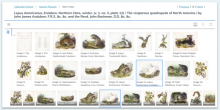Latitude Brown
Posts by Kat Hagedorn

From January-September 2025, we were excited to have the assistance of two interns. Latitude Brown and Andy Nakamura helped us improve descriptive metadata and content in several of our digital collections, particularly those that address potentially objectionable or harmful material. This blog post shares their experiences and highlights the projects they worked on.

We often look for mechanisms to create better and more robust metadata about our materials in our digital collections. The Digital Collections Service partnered with Shapiro Design Lab at U-M Library to use Zooniverse, a crowdsourcing platform that allows us to post existing materials for anyone to view and add descriptive information to. We improved two digital collections using improved metadata from Zooniverse crowdsourcing.

In our inaugural Digital Collections Connection meeting on March 7, 2024, we shared a couple of slides that showcase the history of the technical infrastructure for digital collections at U-M Library. During the session, we heard that this overview of our systems was helpful to content partners in understanding current functionality and limitations. We wanted to take this opportunity to share the diagrams more widely and to provide more context and historical information about the origins of, and recent changes to, our digital collections platform.

After the successful launch of our ArcLight finding aids application on April 19, 2023 - and the deprecating of our homegrown Digital Library eXtension Service (DLXS) finding aids application - we are sharing our reflections on the project with the wider community. This blog post will describe the history of finding aids at the University of Michigan Library and what led us to develop the ArcLight finding aids application, starting in earnest in 2020. We will describe our goals for the project, the organization of the development team, and the modifications that we needed to make to effectively complete the project. We will give an overview of what a finding aids application does, and why we decided to use ArcLight as well as Docker and Kubernetes as our new containerization and hosting solution. We will discuss what was advantageous to us for this project as well as what was particularly challenging, and sum up what we learned from our archives partners and end-users, throughout the project.

It’s been nearly a decade since we last refreshed our image digital collections. At that time, we created a standard web template, constructed consistent help pages, cleaned up our collection home pages, and built what was at the time an easier way to view and interact with the images in the interface. This time, we’re doing more! We have a brand-new interface and a number of additional and improved features.

In November 2108, I was fortunate enough to travel to Fudan University (Shanghai, China) to be a “Foreign Expert” at their library.

Over the past several months, Digital Content & Collections has worked on new procedures for handling accessions from patrons for HathiTrust. What happens if no HathiTrust contributing institution has their volume on their shelves, and the volume is a good addition to the HathiTrust corpus? In these cases, U-M Library steps into the breach. We can easily handle a small throughput of these volumes from HathiTrust, and we handle three kinds of accessions: physical, digital and virtual.

In an upcoming LTT blog post (hopefully, before the end of the calendar year), we will discuss U-M Library's process of enabling page insertions to Google volumes for our HathiTrust Digital Library.

This is a re-posting of a HathiTrust blog post. HathiTrust receives well over a hundred inquiries every month about quality problems with page images or OCR text of volumes in HathiTrust. That’s the bad news. The good news is that in most of these cases, there is something they can do about it. A new blog post is intended to shed some light on the thinking and practices about quality in HathiTrust.

It’s possible we should have written this blog post years ago, when we first created our workflow for how we shepherd digitization projects through our Digital Library. Well, we were busy creating it, that’s our excuse. Three years later, we’re on our third iteration.